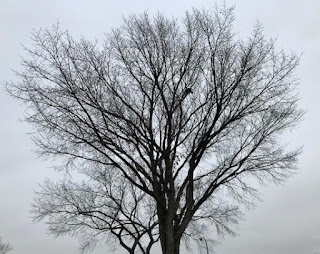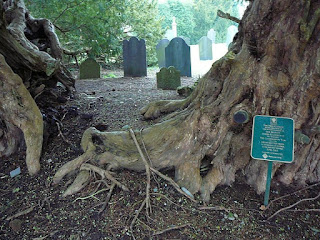by Marie Powell
When we think of Halloween icons, we often think of screeching black cats, howling ghosts, and withered witches with tall black hats. But there’s nothing as common -- or as spooky -- this time of year as the bare branches of a tree against the grey sky, when the wind howls at the end of the day.
Stories of tree spirits and the magical properties of each species abound on the Internet and in books. Stories of spirits and magic were part of the beginnings of science, as people began trying to understand the natural world. Yew trees (Taxus baccata) are often mentioned in folklore and magical contexts. It’s a favourite material for everything from wiccan wands to medieval bows, but the leaves, bark, and seeds contain taxine, which can cause heart problems [Isabella, 2020].
The yew tree is also a symbol for protection and longevity. One old folk tale stars a real tree known as the oldest Yew tree in Wales, the Llangernyw Yew near Conwy, North Wales. It’s estimated to be nearly 5,000 years old, and has a cleft trunk (see photo) that some say is a portal to the world of the dead. [Atlas Obscura, 2020].
The tree is
associated with a spirit called Angelystor. On Halloween,
this spirit enters the north door of the village church to
announce the names of villagers who will die during the upcoming
year—and from all reports, it’s
not a good idea to test this spirit. One tailor who scoffed heard his
own name announced and was dead within the year. [Owen, 2006].
In a lighter vein, the yew tree is also among the trees recommended as a habitat for certain types of birds and animals [BBC]. Trees are considered sacred in many cultures, and have even been graced with magical properties in some. The birch tree, for example, has been connected to creativity and fertility, possibly because it’s one of the first trees to grow back after a forest fire. The oak is considered a symbol of endurance and power. [Wigington, 2019].
Each type and variety of tree has a particular nature. According to The Woodland Trust, noticing a combination of features is the best way to learn about the nature and identity of a tree. Trees differ in several basic elements: the shape, size, and colour of leaves or needles, the texture of its bark, or the types of buds, fruits, and flowers. The overall shape or silhouette of the tree provides a clue. Even the location where the tree can be found helps identify its nature, since some trees prefer to grow near water, while others prefer woodlands or scrubland. [The Wooodlands Trust, ND]
Trees play a role in the lives of many animal and bird species, as a source of food, nesting sites, and roosting spaces. A natural landscape that includes trees is recommended for optimum health. [BBC] Anyone who has ever felt the calming and de-stressing effect of a great old tree could agree that this in itself is potentially magical [Whitehurst, 2020]. Whether or not trees have spirits, they certainly can lift our spirits—hopefully in time for this Covid Hallowe’en!
Marie Powell’s castle-hopping adventures in North Wales have led to the publication of her new series, Last of the Gifted, including Spirit Sight and Water Sight (coming this fall) with Wood Dragon Books (participation made possible through Creative Saskatchewan’s Book Publishing Grant Program). Marie is the author of more than 40 children’s books published by Scholastic Education, Amicus, Learner/Lightning Bolt, and others. Find her at https://mariepowell.ca
Photo credits:
-
Spooky trees - Photo by Marie Powell
-
The Split trunk section of the Llangernyw Yew - Photo by Emgaol on Wikipedia (Creative Commons license)
-
The Llangernyw yew tree in Llangernyw Village, Conwy, Wales - Photo by Emgaol on Wikipedia (Creative Commons license)
Bibliography and Further Reading:
Atlas Obscura. (2020). Llangernyw Yew. Retrieved from Atlas Obcura: https://www.atlasobscura.com/places/llangernyw-yew
BBC. (n.d.). "Planting a tree helps wildlife". Retrieved from BBC Breathing Spaces: http://www.bbc.co.uk/breathingplaces/plant_tree/
Botanical Society of Britain and Ireland. (ND). Mapping the flora of the British Isles. Retrieved from Botanical Society of Britain and Ireland: https://bsbi.org/maps-and-data
Isabella. (2020, 10 21). The Magic of Yew. Retrieved from Speaking of Witch Wands & Magickal Things: https://speakingofwitchwands.net/2017/09/05/the-magic-of-yew/
Owen, E. (2006, December 12). Welsh Folk-Lore: A Collection of the Folk-Tales and Legends of North Wales. Retrieved from Welsh Folk-Lore: http://www.gutenberg.org/files/20096/20096-h/20096-h.htm#page170
The Woodland Trust. (ND). "How to identify trees". Retrieved from The Woodland Trust: https://www.woodlandtrust.org.uk/trees-woods-and-wildlife/british-trees/how-to-identify-trees/
Whitehurst, T. (2017). The Magic of Trees: A Guide to Their Sacred Wisdom & Metaphysical Properties . Llewellyn Publications.



No comments:
Post a Comment